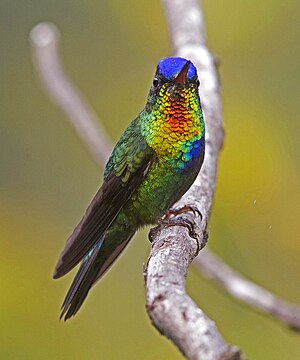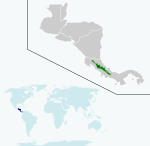Fire-throated hummingbird
| Fire-throated hummingbird | ||||||||||
|---|---|---|---|---|---|---|---|---|---|---|

Fire-throated hummingbird |
||||||||||
| Systematics | ||||||||||
|
||||||||||
| Scientific name of the genus | ||||||||||
| Panterpe | ||||||||||
| Cabanis & Heine, 1860 | ||||||||||
| Scientific name of the species | ||||||||||
| Panterpe insignis | ||||||||||
| Cabanis & Heine , 1860 |
The fire-throated hummingbird ( Panterpe insignis ) is a sailing bird in the hummingbird family (Trochilidae). It occurs from the southwest of Costa Rica to Panama . The IUCN classifies the population as Least Concern .
features
The fire-throated hummingbird reaches a body length of about 11 cm and a weight of about 5.7 g. The top of the head is royal blue while the sides of the head and the nape of the neck are colored black. The back is green. The upper tail-coverts are bluish and turn into dark blue at the tail. The throat glitters pink, copper-orange, which turns into violet-blue in the middle of the chest. The belly is green to bluish. The black beak is colored pink at the base of the lower mandible.
Young animals are similar to the full-grown fire-throated hummingbirds, but have rust-colored hems on the face and neck feathers.
distribution and habitat
The birds can be found near higher mountains in the Cordillera de Guanacaste at the Miravalles volcano as far as Panama. Here they move in the northern Cordillera at altitudes around 1400 meters and in the Cordillera de Talamanca around 2000 meters. After the brood they can also be found at heights of up to 750 meters.
behavior
The birds move mainly in the crowns of forest trees. Every now and then they make trips to shrubs on the edges of the forest, in clearings and in the secondary vegetation. They prefer the flowers of epiphytes , especially of the heather family such as Cavendishia and Macleania or scrub like the Centropogon, which belongs to the bluebell family . They often pierce long, tubular flowers or use the holes that have already been made by hooked beaks ( diglossa ) or bumblebees. They are very lively, noisy and aggressive and defend nutrient-rich plants.
Vocalizations
Your call sounds like a mixture of high-pitched, liquid to sharp and piercing chirping, rattling and buzzing. No real melody can be seen in the males. In courtship they make a humming sound.
Reproduction
The males help with the brood and during this time share their plants with the females. Their nest is a thick calyx made of tree fern fibers, fallen plants and spider webs. They cover the outsides densely with moss and lichen. They build their nests 2 to 4 meters high on bamboo trunks or uprooted trees on overhangs.
Subspecies
There are currently two subspecies:
- Panterpe insignis insignis Cabanis & Heine , 1860. The nominate form is widespread from northern central Costa Rica in the Cordillera de Tilarán to western Panama.
- Panterpe insignis eisenmanni Stiles , 1985. This subspecies occurs only in northwest Costa Rica in the Cordillera de Guanacaste. It differs by a much clearer blue-violet color on the abdomen, chest and upper tail covers. The top of the head is significantly blacker than in the nominate form, with the black extending into the upper area of the back. It also has a significantly shorter beak.
Etymology and history of research
Jean Louis Cabanis and Ferdinand Heine described the hummingbird under the name Panterpe insignis , which is valid today . The type specimen came from the Zoological Museum in Berlin and was collected by Karl Hoffmann in Costa Rica.
The word "panterpe" comes from the Greek word "panterpēs παντερπής " for "completely delightful". The Latin word "insignis" stands for "extraordinary, noteworthy". The word "eisenmanni" honors the American-Panamanian ornithologist Eugene Eisenmann (1906–1981), whom Frank Gary Stiles thanks for motivating him to carry out this research, although this type of research has little reputation in research circles.
literature
- Frank Gary Stiles, Alexander Frank Skutch , Dana Gardner: A Guide to the Birds of Costa Rica . Comstock Publishing Associates, Ithaca, New York 1990, ISBN 0-8014-9600-4 .
- Frank Gary Stiles: Geographic Variation in the Fiery-Throated Hummingbird, Panterpe insignis . In: Ornithological Monographs . 36, Neotropical Ornithology, 1985, pp. 22–30 , doi : 10.2307 / 40168275 ( online [PDF; accessed December 23, 2013]).
- James A. Jobling: Helm Dictionary of Scientific Bird Names . Christopher Helm, London 2010, ISBN 978-1-4081-2501-4 .
- Jean Louis Cabanis, Ferdinand Heine junior: Museum Heineanum Directory of the ornithological collection of Oberamtmann Ferdinand Heine on Gut St. Burchard in front of Halberstatdt. With critical comments and a description of the new species, systematically edited by Jean Cabanis, first custodian of the Royal Zoological Collection in Berlin and Ferdinand Heine, Stud. Philos. In: III. Part, containing the shrill birds and the compilation of the genera and species of 1-3, Thiels. tape 3 . R. Frantz, Halberstadt 1860 ( biodiversitylibrary.org ).
Web links
- Panterpe insignis inthe IUCN 2013 Red List of Threatened Species . Listed by: BirdLife International, 2012. Retrieved December 23, 2013.
- BirdLife International: Species Factsheet - Fiery-throated Hummingbird ( Panterpe insignis ) . Retrieved December 23, 2013.
- Videos, photos and sound recordings of Fiery-throated Hummingbird (Panterpe insignis) in the Internet Bird Collection
- Fire-throated hummingbird ( Panterpe insignis ) at Avibase; Retrieved December 23, 2013.
- Panterpe insignis in the Integrated Taxonomic Information System (ITIS). Retrieved December 23, 2013.
- xeno-canto: Sound recordings - Fiery-throated Hummingbird ( Panterpe insignis )
- Fiery-throated Hummingbird (Panterpe insignis) in the Encyclopedia of Life . Retrieved July 16, 2019.
